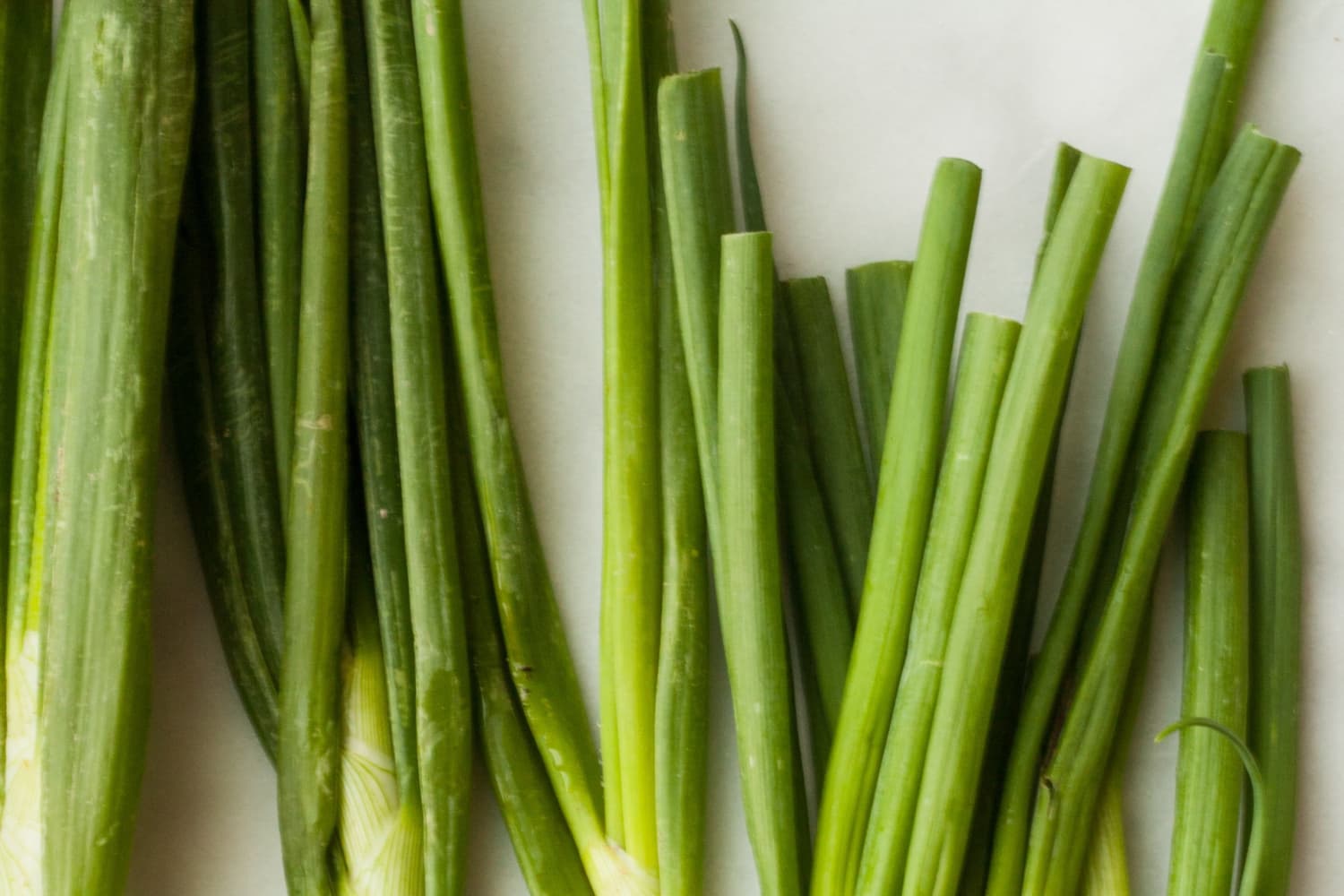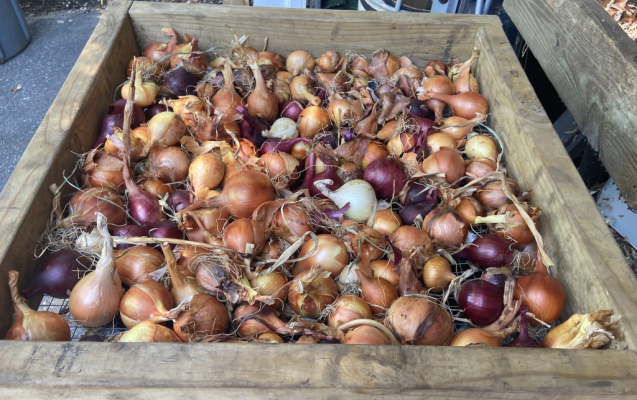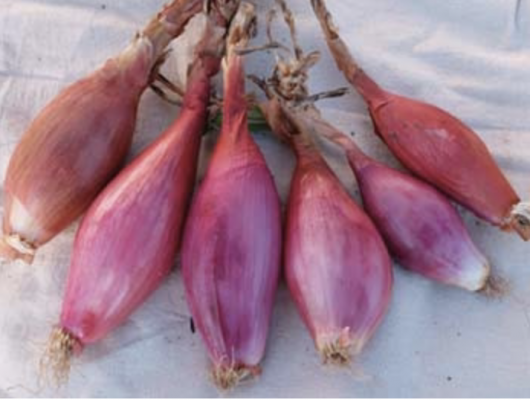At one time I did have to chop up a large amount (think it was 10#) I wore goggles but it didn't help as those air borne brats went up my nose, into the tear ducts and my eyes still teared up. LOL that's when I learned to run the knife under water - frequently.
You are using an out of date browser. It may not display this or other websites correctly.
You should upgrade or use an alternative browser.
You should upgrade or use an alternative browser.
Red onion vs white onion vs green onion
- Thread starter georgevan
- Start date
The friendliest place on the web for anyone that enjoys cooking.
If you have answers, please help by responding to the unanswered posts.
If you have answers, please help by responding to the unanswered posts.
Badjak
Sous Chef
- Joined
- Dec 24, 2010
- Messages
- 554
I recall my sunt wearing a mask and snorkel cutting onions.
Absolutely hilarious, but it worked.
Our onion choice is red onion (sometimes available) and onion.
No idea what variety.
Sometimes fresh onions with the leek still attached. They are great as I eat the leek as well
Absolutely hilarious, but it worked.
Our onion choice is red onion (sometimes available) and onion.
No idea what variety.
Sometimes fresh onions with the leek still attached. They are great as I eat the leek as well
Whereas Spring Onions and/or Scallions are much smaller and the whole onion is used, often separated with the whites being slightly cooked and the chopped green been used as decoration and flavour sprinkled on top.
Sounds like you are referring to the part of the green onions that are white?
Or Badjak could mean spring onions, which have the green stalk/leaf still attached, and leek may have been a misused word.
Spring onions are not called scallions/green onions here. They are more mature and have an actual bulb, which is usually fairly big, and the flavor is more mellow.

Spring onions are not called scallions/green onions here. They are more mature and have an actual bulb, which is usually fairly big, and the flavor is more mellow.

Last edited:
Yeah, I know but was too lazy to look up all three.
Or maybe Badjak just meant the green part sprouting out of a regular, full sized onion. My Danish mum used to call scallions "leeks".
And, as to leeks, the ones in Europe, or at least in Denmark, seem to be a slightly different variety than what we see here. They taste better to me. A lot of the green part of the leek leaves do get used in cooking there. They are not nearly as fibrous as the green parts of leeks that I get on the left side of the Atlantic.
And, as to leeks, the ones in Europe, or at least in Denmark, seem to be a slightly different variety than what we see here. They taste better to me. A lot of the green part of the leek leaves do get used in cooking there. They are not nearly as fibrous as the green parts of leeks that I get on the left side of the Atlantic.
blissful
Master Chef
- Joined
- Mar 25, 2008
- Messages
- 6,361
In the spring, my long keeper yellow onions begin to sprout. I usually dice and freeze the white part at that point, but I also use the green part of the onion. The green part can be used like spring onions.
taxy, the left side of the Atlantic, is that the left side when you are facing the Atlantic or the left side when your back is to the Atlantic...
runs and hides...
runs and hides...
rodentraiser
Head Chef
I like the red onions for putting on hamburgers. White onions go in my soup (cooks for 8 hours), I cook with yellow onions (the smell of ham and onions cooking in butter will have me swooning) and I use sweet onions when I put onions, tomatoes, and cheese on tortillas because I eat those raw. Green onions and chives are sprinkled over potatoes of any kind.
Well if your back is to the Atlantic and you are standing on land, the left is south...taxy, the left side of the Atlantic, is that the left side when you are facing the Atlantic or the left side when your back is to the Atlantic...
runs and hides...
Only in the Americas. In Europe and Africa the left is north, when standing with your back to the Atlantic.Well if your back is to the Atlantic and you are standing on land, the left is south...
Badjak
Sous Chef
- Joined
- Dec 24, 2010
- Messages
- 554
What I am referring to are onions, just out of the ground, with the green growth still attached.View attachment 66675 Not a good picture but I think you and I call them different names. Leeks are very large and thick, the heavy green tops are only used for maybe stock flavouring. The whites are the main part that is used, cooked into casseroles, soups, stews. Mild and very yummy.
Whereas Spring Onions and/or Scallions are much smaller and the whole onion is used, often separated with the whites being slightly cooked and the chopped green been used as decoration and flavour sprinkled on top.
Sounds like you are referring to the part of the green onions that are white?
This "growth" gets removed for onions that are dried.
By want of a better name, I call that green part leek as well as the "proper" leek.
(Sounds confusing, even to myself)
Green onions and spring onions are just 2 names of the same thing, aren't they? Here I use the green bit like chives.
By the way, I eat the green part of the proper leeks as well as the white bit
Badjak
Sous Chef
- Joined
- Dec 24, 2010
- Messages
- 554
Yes, those are what I mean.Or maybe Badjak just meant the green part sprouting out of a regular, full sized onion. My Danish mum used to call scallions "leeks".
And, as to leeks, the ones in Europe, or at least in Denmark, seem to be a slightly different variety than what we see here. They taste better to me. A lot of the green part of the leek leaves do get used in cooking there. They are not nearly as fibrous as the green parts of leeks that I get on the left side of the Atlantic.
Spot on
The green part of leeks here in Montreal and I believe in most parts of North America are fibrous and unpleasant to eat.What I am referring to are onions, just out of the ground, with the green growth still attached.
This "growth" gets removed for onions that are dried.
By want of a better name, I call that green part leek as well as the "proper" leek.
(Sounds confusing, even to myself)
Green onions and spring onions are just 2 names of the same thing, aren't they? Here I use the green bit like chives.
By the way, I eat the green part of the proper leeks as well as the white bit
Yes, well I was assuming you were in Canada, sooooooo...Only in the Americas. In Europe and Africa the left is north, when standing with your back to the Atlantic.
larry_stewart
Master Chef
I'm a 'Primarily yellow onion' kinda guy. I don't notice a huge amount of difference ( other than color) too keep multiple varieties on hand.
During the seasons I get a long-day variety pack of onions to grow ( yellow, red and white) for variety, then another pack of only yellow ( Patterson onions) which are good for long-term storage. I find the white ones to be the strongest flavor ( raw) although all onion dull down and sweeten up a bit when cooked. I do like the contrast of colors when I make a bean salad ( preferably the red) but I usually wont go out of my way to get it, unless I have them from the garden. Leeks I primarily use for potato leek soup ( I'd write vicchysoise, but I never get the spelling right on the first try, and am too lazy to look it up ). I only use the whites and the pale green portions for the soup, but sometimes I will use the darker leaves for a stock, cause I kinda feel bad throwing half the vegetable away ( into the compost). I don't notice enough difference in shallots ( to onions) to use them regularly, but will occasionally use them. I did grow them in the garden a few times, but they are never larger than a large garlic clove, so its a pain in the but to peal a dozen, just for one recipe. But, I do use there greens in place of scallions or chives, cause they send up multiple skinny leaves ( thiner than onions but thicker than chives) all at once, so within a few weeks, I have the mother - load of 'scallions'. They also store for ever so I'll stick them in small vacant areas the garden too have a continuous flow. In general, I find most onions interchangeable when cooked ( with few exceptions). The main reason I may select different colors is when making some kind of salad, and looking for a cool contrast of colors.
). I only use the whites and the pale green portions for the soup, but sometimes I will use the darker leaves for a stock, cause I kinda feel bad throwing half the vegetable away ( into the compost). I don't notice enough difference in shallots ( to onions) to use them regularly, but will occasionally use them. I did grow them in the garden a few times, but they are never larger than a large garlic clove, so its a pain in the but to peal a dozen, just for one recipe. But, I do use there greens in place of scallions or chives, cause they send up multiple skinny leaves ( thiner than onions but thicker than chives) all at once, so within a few weeks, I have the mother - load of 'scallions'. They also store for ever so I'll stick them in small vacant areas the garden too have a continuous flow. In general, I find most onions interchangeable when cooked ( with few exceptions). The main reason I may select different colors is when making some kind of salad, and looking for a cool contrast of colors.
When the recipe calls for minced or finely chopped, I really dont care much, but if there diced or sliced, I prefer a ' meatier' onion that has thicker layers, so they dont get lost in the dish. I also prefer onions slightly oblong , as compared to round, so when you cut off the ends prior to pealing, you cut off as little as possible ( Unless Im making a stuffed onion, in which round is a more workable shape).
In the winter, if there are no viable green ons outside to use, I'll ge a bunch of scallions and cut them down to about and inch or two to the root end. I will then put them in a glass ( so the roots are submerged ) by a window, and it will continuously produce more green leaves to use. If the soil is workable outside, I'll just thumb them into the grown and let them grow. Eventually they will go to seed, but I can still get many green leaves to use.
Last year I tried a new variety ( new to me), that I think I heard about while watching Stanley Tucci's cooking/ Italy show. They are called " Red Torpedo Tropea Onions". They store well, and are not too big, so its a nice size to use for 2 people, and not have half of an onion shrivel up, and disappear in the fridge.
During the seasons I get a long-day variety pack of onions to grow ( yellow, red and white) for variety, then another pack of only yellow ( Patterson onions) which are good for long-term storage. I find the white ones to be the strongest flavor ( raw) although all onion dull down and sweeten up a bit when cooked. I do like the contrast of colors when I make a bean salad ( preferably the red) but I usually wont go out of my way to get it, unless I have them from the garden. Leeks I primarily use for potato leek soup ( I'd write vicchysoise, but I never get the spelling right on the first try, and am too lazy to look it up
When the recipe calls for minced or finely chopped, I really dont care much, but if there diced or sliced, I prefer a ' meatier' onion that has thicker layers, so they dont get lost in the dish. I also prefer onions slightly oblong , as compared to round, so when you cut off the ends prior to pealing, you cut off as little as possible ( Unless Im making a stuffed onion, in which round is a more workable shape).
In the winter, if there are no viable green ons outside to use, I'll ge a bunch of scallions and cut them down to about and inch or two to the root end. I will then put them in a glass ( so the roots are submerged ) by a window, and it will continuously produce more green leaves to use. If the soil is workable outside, I'll just thumb them into the grown and let them grow. Eventually they will go to seed, but I can still get many green leaves to use.
Last year I tried a new variety ( new to me), that I think I heard about while watching Stanley Tucci's cooking/ Italy show. They are called " Red Torpedo Tropea Onions". They store well, and are not too big, so its a nice size to use for 2 people, and not have half of an onion shrivel up, and disappear in the fridge.
Attachments
Yes. If used for anything besides compost, it's generally stock.The green part of leeks here in Montreal and I believe in most parts of North America are fibrous and unpleasant to eat.
Andy M.
Certified Pretend Chef
Actually, no they are not. https://foodsubs.com/groups?a=&name=spring+onions. . . Green onions and spring onions are just 2 names of the same thing, aren't they? Here I use the green bit like chives.
By the way, I eat the green part of the proper leeks as well as the white bit
Similar threads
- Replies
- 10
- Views
- 284


